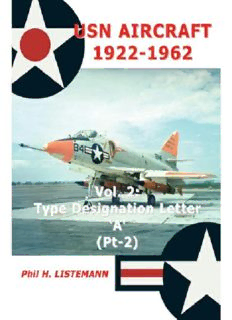
USN Aircraft 1922-1962: Type designation letter ’A’ Part Two PDF
Preview USN Aircraft 1922-1962: Type designation letter ’A’ Part Two
NOTAM: This study was undertaken using the available movement cards of each USN aircraft in service between 1922 and 1962. These cards may occasionally contain errors which could lead to some disparities or omissions when the text below is compared with official or non-official publications already published. Alphabetical order has been chosen to structure the book (except sometimes for prototype), rather than the chronological order of introduction into USN/USMC/USCG service. Unless otherwise noted, the photographs come from the USN or from sources such as the National Archives or National Museum of Naval Aviation. eISBN: 978-2918590-30-9 Copyright © 2014 Philedition - Phil Listemann www.raf-in-combat.com All right reserved. No part of this book may be reproduced, stored in a retrieval system or transmitted in any form by any means, electronic, mechanical, photocopying, recording or otherwise, without prior permission of the author. Contents Type Designation Manufacturers Code Special Purpose Suffix A: Attack (1946-1962) XA2D-1 A2D-1 XA3D-1 A3D-1 A3D-1P A3D-1Q A3D-2 A3D-2P A3D-2Q A3D-2T XA4D-1 A4D-1 YA4D-1 A4D-2 YA4D-2 A4D-2N YA4D-2N A4D-3 A4D-4 A4D-5 A4D-6 AF-1S AF-1W AF-2S AF-2W AF-3S A2F-1 A2F-1Q YAH-1 Over forty years, between 1922 and 1962, the USN and USMC used a designation system which began with biplanes and ended with jets, having been used through two major wars, WW2 and the Korean War. This system remained largely the same during that time, though it evolved with the introduction of new types and technology, and new exceptions developed as well. The purpose of this series is to explain this system using photographs. On 18 September 1962, a new system was introduced that was common to the three air arms (USAF, Army and USN/USMC) and which is still in force today. The application of this Tri-service system was effective immediately for aircraft pending delivery to the USN, but took a couple of weeks to be implemented fully in the case of aircraft already accepted, especially for aircraft based overseas or cruising on aircraft carriers. The designation system was based on: 1 - A type designation which describes the basic mission of the aircraft. 2 - A letter designating the manufacturer (but not necessarily the designer) following the type designation. 3 - A configuration sequence indicating minor change to the aircraft type, the initial model being designated ‘1’. 4 - Manufacturer type sequence. 5 - Status prefix. Only two letters were assigned, ‘X’ - Experimental - and ‘Y’ - Service test - from 1951 onwards. 6 - Special Purpose Suffix which indicates an aircraft used in a special configuration. Samples: AD-6: Douglas First Attack type, sixth model. F2A-1: Brewster Second Fighter type, initial model. A3D-2P: Douglas Third Attack type, second model, reconnaissance version. PB4Y-1: Consolidated Fourth Patrol Bomber type, initial model. TYPE DESIGNATION Ambulance 1943-1946 A Attack 1946-1962 Bomber 1931-1943 B Bomber-Fighter 1934-1937 BF Bomber-Torpedo 1942-1945 BT Anti-Submarine Drone 1959-1962 DS Fighter 1922-1962 F Transport, Single-Engined 1939-1941 G Inflight refuelling Tanker 1958-1962 Hospital 1929-1943 H Helicopter 1943-1962 Transport 1926-1931 J General Utility 1931-1955 Utility Transport 1935-1955 JR Glider 1941-1945 L Marine Expeditionary 1922-1923 M Trainer 1922-1960 N Observation 1922-1962 O Observation Scout 1935-1945 OS Pursuit 1923 P Patrol 1923-1962 Patrol-Bomber 1935-1962 PB Patrol, Torpedo-Bomber 1937 PTB Racer 1922-1928 R Transport 1931-1962 R 1954-1959 1954-1959 RO Rotorcycle Anti-Submarine 1951-1962 S Scout-Bomber 1934-1946 SB Scout-Trainer 1939-1962 SN Scout-Observation 1934-1946 SO Torpedo 1922-1935 T Transport 1927-1930 Trainer 1948-1962 Torpedo-Bomber 1935-1946 TB Target Drone 1942-1946 TD Torpedo-Scout 1943 TS Utility 1955-1962 U 1946-1955
Description: